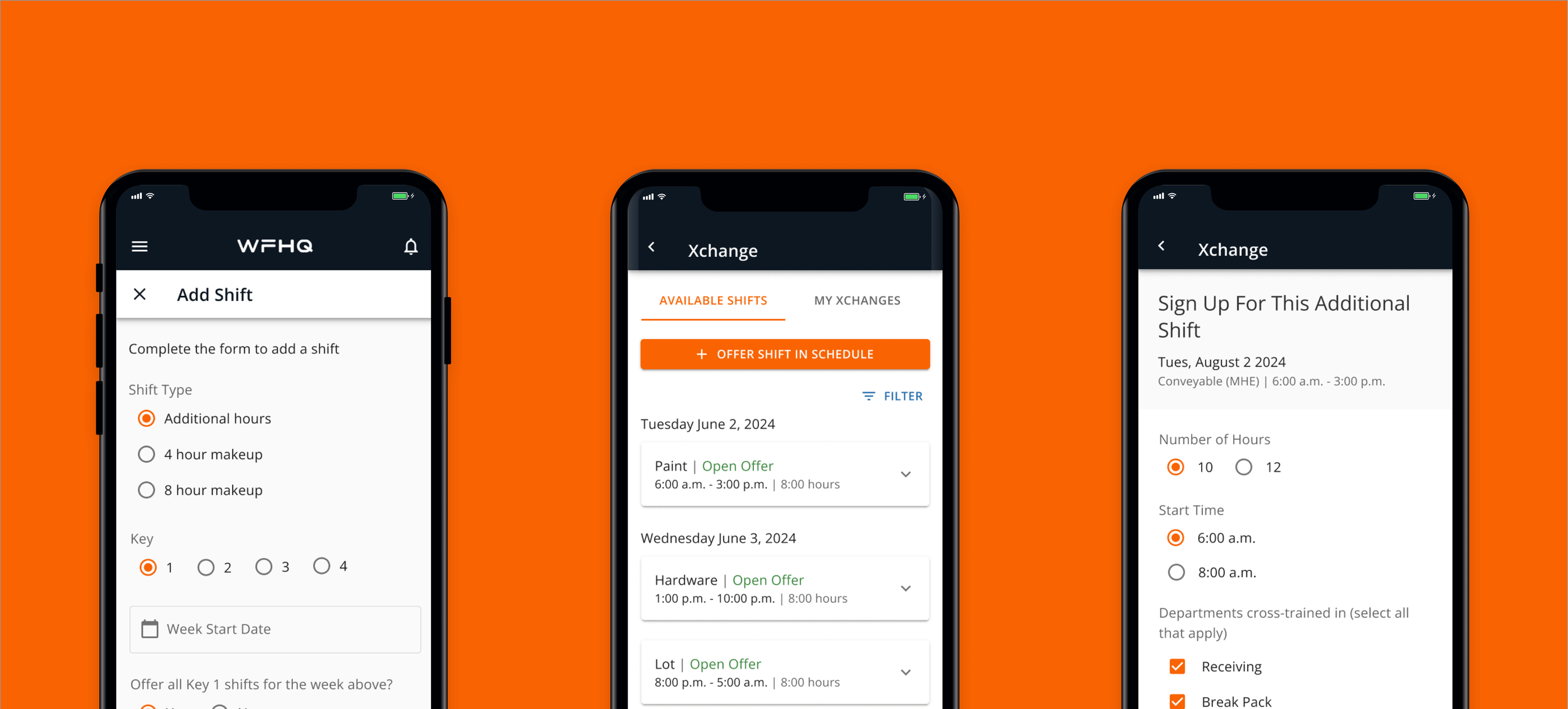
The Home Depot: Workforce Xchange for Supply Chain
My Role: User Research, Strategy,
UX, UI, Prototyping, Testing
Team: Myself as the sole designer, Product Manager, Engineering
Tools: Miro, Figma
The Challenge
The Workforce Tools app allows store employees to offer and claim shifts on a marketplace called Workforce Xchange, ensuring stores always have the coverage they need, and that employees have the flexibility to change their schedule without impacting the business.
For these reasons, internal stakeholders at THD were interested in expanding this feature’s availability to supply chain (distribution center) employees.
Scheduling in distribution centers operates quite differently from stores, so extensive research was required to determine the best way to adapt and implement Xchange for supply chain associates.
Discovery
Primary Research: In-Person User Interviews
I visited a nearby THD distribution center to interview leaders and associates, while conducting remote interviews with several other locations across the country, in order to get a sampling from all different facility types.
Getting a tour of the distribution center
Findings
The more rigid nature of DC scheduling vs store, as well as the much lower proportion of part-time associates, meant that there wasn’t a strong need for the currently live version of Xchange
The pain point that came up most in interviews was the offering of overtime, currently a very manual process.
Examples of current overtime sign-up process
Advocating to Stakeholders
Product stakeholders had initially expected to be able to port over the exisiting store version of Xchange to distribution centers as a V1, but when my research uncovered the overtime case as the biggest problem on the DC side, I argued that solving this problem first would promote field adoption of the feature on day one, and lay better groundwork for future expansion, while creating major efficiency gains in the short term.
Once I had the support of my product team in advocating for a shift in product direction, I presented to the operations team, got them on my side, and used their field expertise to help in providing backup in final product stakeholder conversations.
Ideation
User Flows
Based on research insights, I created user flows for the current overtime process, and what an Xchange version of that process might look like.
Mapping the current process
Wireframes
Since I would be designing within an already established design system and creating a new version of the current process, I went straight to wireframing the overtime shift creation form and associate claim process, making sure I was accounting for all required fields to match a very complex system.
Testing
Usability Testing
I then created a prototype I could test with distribution center leaders and associates to validate all fields in the shift creation and shift claiming screens, and uncover any additional information leaders would need to have to approve a shift claim.
Response to the prototype was very positive, with many leaders and associates extremely excited by the idea of streamlining the process and making their jobs easier. There were a few takeaways that impacted the final designs, but overall leaders and associates had no trouble navigating the prototype.
Final Designs
Using insights from usability testing, I made updates to the screens as needed and scaled them up to high fidelity using components from our Workforce Management design standards.
Leader Flow
Associate Flow
Next Steps
in piloting the first iteration of Xchange for supply chain at 3 locations, we got great feedback from distribution center leaders on time saved and saw a notable decrease in unfilled overtime shifts
There were plans to roll out to all locations and implement a version of the store Xchange format in addition to the overtime case, but I left the company before these things could be accomplished.
Reflection
I found the research and testing aspects of this project to be extremely fulfilling, allowing me full access to users who were actually excited to talk to me for the first time in my UX career. Having to pivot from our team’s imagined solution based on research findings felt like detective work in the best way, and using those insights in stakeholder conversations gave me ammo to advocate for my proposed direction. Ultimately, seeing the positive results and hearing how excited leaders and associates were about the feature made it all worth it.







